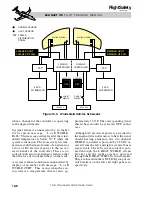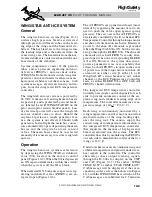
Icing conditions also exist when the SAT on
the ground and for takeoff is 10° C (50° F) or
below when operating on ramps, taxiways or
runways where surface snow, ice, standing
water, or slush may be ingested by the en-
gines, or freeze on engine nacelles, or engine
sensor probes.
ICE DETECTION
ICE DETECTOR SYSTEM
The airplane ice detection probe is mounted
on the underside of the fuselage, just outboard
of the left nose wheel well door. The sensor
is a cylindrical probe that extends approxi-
mately 1.25 inches beyond the skin surface
(Figure 10-1).
The ice detector probe, or sensing element is
an ultrasonic axially vibrating rod that changes
frequency when an ice build-up is detected.
The frequency change corresponds to, and is
proportional to a preset ice thickness. When
triggered, the detector unit sends a signal to
initiate an “ICE DETECTED” CAS message
that will be displayed for approximately 60
seconds to alert the crew of the icing condi-
tions. The detection system also monitors the
wing/stabilizer and nacelle anti-ice switch
positions. If ice is detected with all of the
anti-ice equipment turned on, the “ICE DE-
TECTED” CAS message will be white and if
any of the equipment is not turned on, it will
be amber. The detector probe initiates an au-
tomatic deicing cycle after ice has been de-
tected. The ice detector deices itself through
integral heating elements until the frequency
is restored to a preset point. The heaters are
then left on for an additional 4-5 seconds to
ensure complete deicing of the probe.
Once the probe has deiced, the heating ele-
ments are de-energized. If ice subsequently
accumulates on the probe, the “ICE DE-
TECTED” CAS message is again displayed
and the deicing cycle will be initiated.
The ice detector system automatically con-
ducts a self-test on initial power-up, and re-
ceives 28 VDC power from the right essential
bus. The system is protected by the ICE DE-
TECT circuit breaker located within the ANTI-
ICE group on the copilot circuit breaker panel.
Since the ice detector probe always
has power applied whenever the air-
plane electrical system is powered,
the ice detector probe may be hot to
the touch. If the ice detector probe
is touched or bumped, the ice de-
tector will sense this as ice, and will
try to deice the probe causing the
probe to get extremely hot.
The EICAS displays the following CAS mes-
sages for the ice detection system:
• “ICE DETECTED” (white)–This mes-
sage is displayed when the system de-
tects an ice build-up, the airplane is
airborne and the following anti-ice sys-
tems are ON:
– WING/STAB
– L NAC (left nacelle)
– R NAC (right nacelle)
WARNING
L E A R J E T 4 5
P I L O T T R A I N I N G M A N U A L
10-2
FOR TRAINING PURPOSES ONLY
L E A R J E T 4 5
P I L O T T R A I N I N G M A N U A L
FlightSafety
international
FlightSafety
international
Figure 10-1. Ice Detector Probe






























